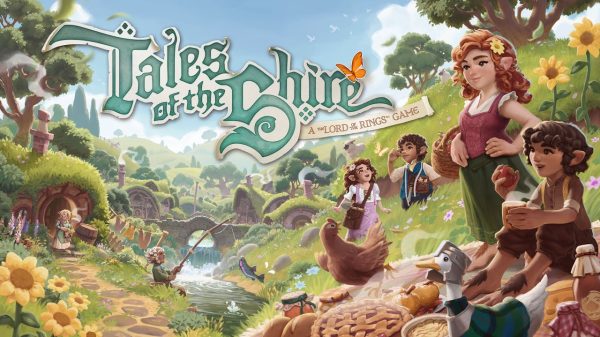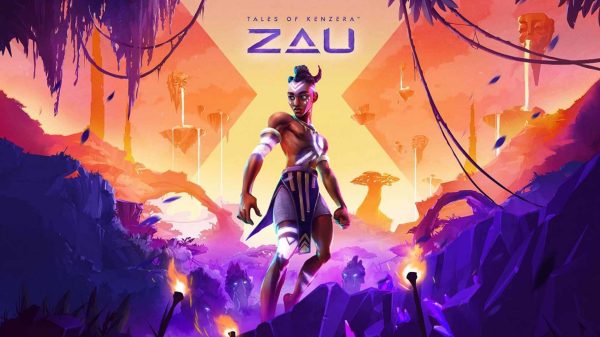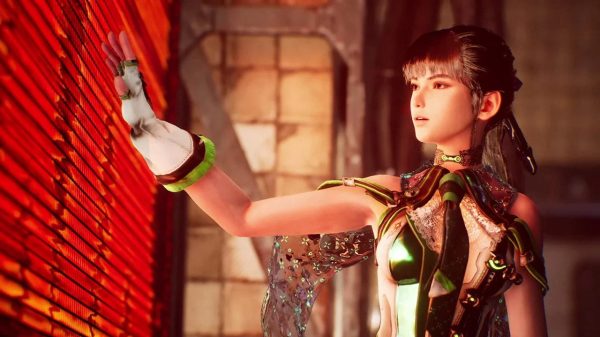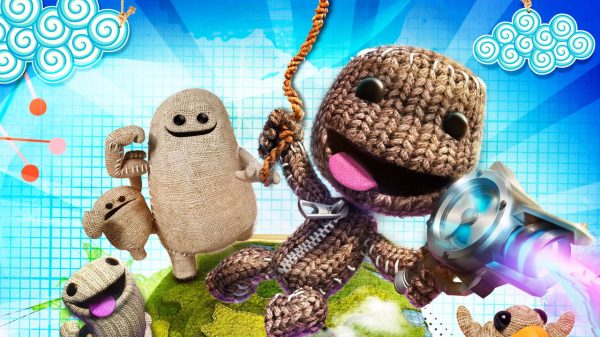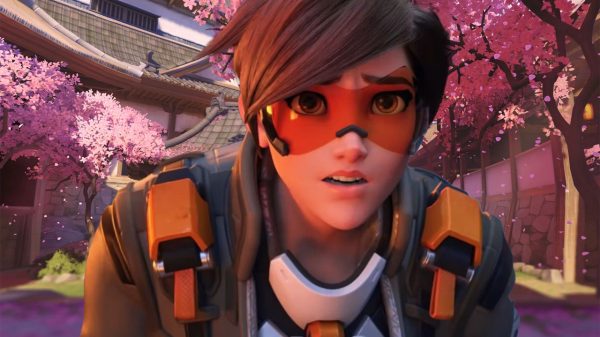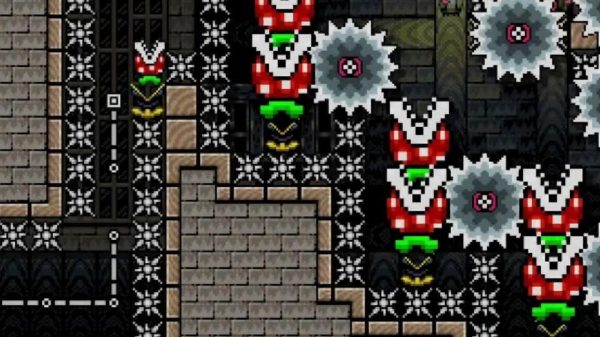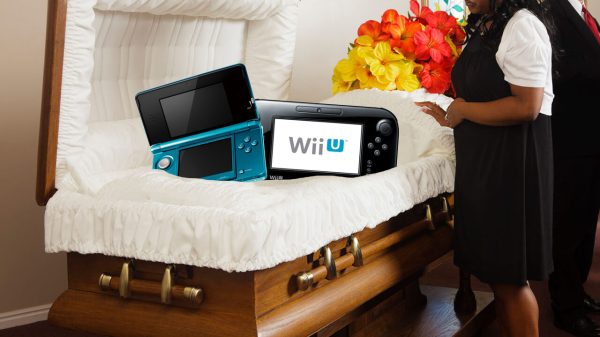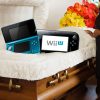The colour grey is probably the most underestimated colour in video game history. The PlayStation’s unassuming grey body masked a rainbow of change to the entire medium. The colour joined hands with brown to define an entire generation’s aesthetic in the last decade. The Super Nintendo, the Big N’s great comeback after SEGA’s greater return, was a dull grey; like the PlayStation, it too was more colourful than it appeared.
But perhaps the most iconic of the greys is also the smallest. It fit into your hands, it was humble in its power – and it changed video games forever. Its library was large, its life was long, and its legacy is legendary. What is there to say, really, about Nintendo’s greatest success that hasn’t already been said? After all, it celebrated its 30th birthday yesterday…but it has aged with grace.
‘Nintendo’s GameBoy, an interchangeable cartridge system that plays a host of arcade-style games via a hand-held unit, is sure to bring hot video action anywhere you want it […] GameBoy could very well change the way we look at video games.’
GamePro magazine, July-August 1989

The late 1980s were a golden age for Nintendo. They’d revived a North American video game industry single-handedly (and irreversibly), and their rule of the console space was unquestioned. While the Nintendo Entertainment System (known as the Famicom in Japan) was undoubtedly the product to have, Nintendo were not one to rest on their laurels. At least, not yet.
The Game Boy was not the first handheld console – Milton Bradley’s Microvision system predates it by a whole decade – nor was it even Nintendo’s. That honour goes to a device even more humble than the Game Boy. In 1985, the world was graced with the Game and Watch; a small entertainer with enormous implications. The legend goes that Nintendo engineer Gunpei Yokoi got the idea for the Game and Watch, this small and discreet toy for anyone, by watching a man idly playing with his calculator on the train.
But, while the Game and Watch borrowed identical technology from the pocket calculator, there was another inspiration: the Microvision. The story of Yokoi’s commuter inspiration is true, but that isn’t the whole story. One of the Game and Watch’s other pioneers, Satoru Okada, recalls the internal struggle of improving upon the American design:
‘…we did not understand why the [Microvision] had to be so big! So we first tried to make a portable console that people could really carry in their pockets, except that the screen resolution was very poor and the graphics were very abstract. Besides, we also thought that the idea of interchangeable cartridges was interesting but because of the Microvision’s limitations, all the cartridges looked the same, both with their graphics and the concept of the games. So we said to ourselves: ‘Why not have just one game per machine but with good graphics at least.’ […] All of this led to the birth of the Game & Watch.’
The Game and Watch was a success, despite its high price tag of 5800 Yen (87 Australian dollars today!), selling 43.4 million units over its lifespan. Its triumphs in the outside world proved that not only was there was a market for handheld games, but that it was a big one, lighting up the eyes of Nintendo’s executives and engineers alike. This passion would prove fruitful in the months to come, as the company reached for the stars.
Thus, work began on a true handheld system. Unfortunately, its nature wasn’t quite clear yet and the conflicting ideas of the project’s biggest men weren’t helping. Yokoi believed that a closer successor to the Game and Watch was the right option, focusing on ‘quick games’ that were intended as distractions more than experiences. Okada, meanwhile, argued (literally) for a console that more closely resembled the Famicom, with its interchangeable cartridges. After all, the Microvision proved that it could be done; they just needed better technology.
In the end, Yokoi relented. The Game Boy’s nature was decided, but its technology was all but certain. Nintendo’s utmost priority was for the system to be cheap, which meant making the system less technologically impressive with each new development iteration. The Game Boy’s iconic monochrome display was the end result, with the bonus of dramatically boosting its battery life. The D-Pad, an invention Yokoi designed to make the Game and Watch less cluttered with buttons, was re-used because of its universal function. The in-built speaker was tinny, but it did its job. To compensate, each Game Boy came bundled with earphones to bring the sound into stereo – amongst other things. Yokoi would later come around to Okada’s approach:
“When we were designing the Game Boy hardware, we took into consideration what kind of software was going to be made for it, and I think that approach resulted in a very efficient product. […] when you make hardware without taking into account the needs of the eventual software developers, you end up with bloated hardware full of pointless excess.
The name of the system, as the legend goes, was inspired by the one of the great technological leaps of the 1980s: Sony’s Walkman. Its legacy, much like the Game Boy’s, cannot be underestimated. It freed music from its chains, allowing it to be taken anywhere. Nintendo wanted the Game Boy to do the same for video games, and its audience was considerably younger than Sony’s, so the name was seemingly obvious. ‘The name Game Boy not only carries echoes of Walkman,’ wrote Dennis Lynch for the Chicago Tribune in 1989, ‘but also reminds us of the target audience for the product: game boys everywhere.’
The runaway success of the NES a mere half-decade before in the West was in no small part due to a fantastic pack-in game, one that would become iconic in its own right: Super Mario Bros. For Nintendo, it was only natural for the Game Boy to have its own bundled Italian plumber simulator. Super Mario Land was designed by Nintendo’s R&D1 department; the same that housed Yokoi and Okoda. It would go on to become a best-seller for the console, and a critical success.
But it wasn’t the pack-in game, was it?

Across the Sea of Japan (and a few hundred kilometres of land), blocks were falling. A Russian software engineer called Alexey Pajitnov had designed a game that was getting his peers addicted across the Soviet Union. It was called Tetris, named after ‘tetromino’ (any shape made from four squares) and ‘tennis’ – Pajitnov’s favourite sport. It was a simple puzzle game, yet its hypnotic powers were undeniable. As soon as it left the Soviet Union through a mixture of shareware and a doomed licensing ‘deal’, its legacy was assured. But not yet.
The Consumer Electronics Show of 1988 held a booth by Spectrum HoloByte, who had obtained the ‘rights’ to Tetris and were finally showing Pajitnov’s marvellous game outside of the Communist world. The game caught Henk Roger’s eye, and the die was cast. Japanese video games already knew Rogers; he’d designed The Black Onyx in 1984, a game credited with the birth of the JRPG. So when he approached then-President of Nintendo of America, Minoru Arakawa, with the prospect of packaging Tetris with the Game Boy, Arakawa took it seriously.
After a series of negotiations with the Soviet software export authorities, Nintendo secured the console and handheld rights to Tetris in 1989. It would be packaged with every Game Boy and come to define the console’s legacy. It also happens to be Pajitnov’s favourite version, even now. Unfortunately, it arrived too late to see the Game Boy’s launch in Japan on the 21st of April 1989 – 30 years ago. Nevertheless, Tetris is now the most iconic video game ever made. It has been ported to almost anything with a screen, but the Game Boy version is most responsible for its explosion into the human consciousness:
‘Tetris made Game Boy and Game Boy made Tetris. It was the perfect platform for the game, since you could carry it around. That’s how it caught on.’
Henk Rogers, 2014

Of course, the Game Boy was not without its competitors; an idea is almost never isolated. The conservative hardware of the system made it a seemingly easy target. It was hardly impressive even by 1989’s standards, a fault that the usurpers were keen to exploit. Nintendo would soon find themselves in a ring that was becoming crowded with contenders – and their corpses.
Atari had lost big during the North American market crash. Billions of dollars and an 80% market share were lost in a swamp of ineptitude. Atari hadn’t been screening their platforms’ releases to ensure their quality and had ‘cannibalised’ its userbase by supporting its 2600 and 5200 consoles at the same time. By early 1983 this had capsized the entire boat, regardless if you were Atari or not. The company would, rather poetically, bury thousands of unsold stock in the New Mexico desert (it was dug up again in 2014).
Now, they were eager to recapture their lost glory with hardware they hadn’t even made. Atari licensed a handheld console called the ‘Handy Game’ in 1989 and put it to market in September of that year. Its new name was ‘Lynx’, and it was the first colour handheld console. That alone made it seem worlds ahead of Nintendo’s grey brick.
Computer manufacturer NEC were also keen to enter the fray. Its 1987 ‘PC Engine’ console had performed very well in Japan, and the North American market seemed wide open. Rebranding it as the ‘TurboGrafx 16’ (despite the name, it was an 8-bit console), it came to American shores in 1989…and flopped. NEC weren’t giving up, though. They had a CD add-on coming and had the hunch that the world was ready for CD games. In 1990, the ‘TurboExpress’ [seen left] came into the world. Sporting a full-colour screen, a TV tuner and the capacity to play non-CD PC Engine games, it seemed like a perfect way to get people on board with buying either system. Who could resist such a tempting offer?
Last, but certainly not least, was SEGA. After a poor initial reception in North America, their Genesis console (known as the Mega Drive everywhere else) was doing much better by the end of 1990. Their new pack-in game, Sonic the Hedgehog, and a revised marketing campaign that set the bar for aggressiveness were masterstrokes that set the stage for the greatest rivalry in video game history. In the early 90s, SEGA could boast a greater North American market share than even Nintendo in the 16-bit circle.
SEGA were flying high and were as quick to capitalise on their fortune as their mascot was on their feet. In 1990, they put out the Game Gear, another colour handheld. Compared to the Lynx, the Game Gear had a library worth playing. It was also coming from the (then) coolest company in the world. The Game Gear should have been a shoo-in!
But it wasn’t. The Lynx and TurboExpress failed even harder. As the years passed, all those who opposed Nintendo’s pocket wall fell. SEGA tried again with the ‘Nomad’, but that floundered along with SEGA’s other post-Genesis mistakes. But how? How did a console that was severely underpowered triumph over all of its competitors? Put simply, Nintendo resisted the temptation to fly ever higher technologically – and melt their wings.
As stated before, the Game Boy’s underpowered nature gave it immense battery life; around 11 hours from four AA batteries. In contrast, the Mega Drive and Lynx could only manage up to five hours from six AAA batteries, and the TurboExpress only managed three hours from the same power source. Even worse, the technological advances of the challengers made their prices significantly higher than those of the Game Boy. While the Game Gear at least enjoyed moderate success, it would never overtake the Game Boy.
Only the Game Boy could overtake the Game Boy. The ‘Game Boy Pocket’ emerged in 1996, needing only two AAA batteries for 10 hours of battery life. Yes, AAA. That was also on an improved LCD screen, an even smaller body and a price that was almost cut in half. By then, it would inherit its chunkier brother’s extensive library as well…including a game that defined a generation.
‘“After we released the Game Boy, one of my staff came to me with a grim expression on his face: “there’s a new handheld on the market similar to ours…” The first thing I asked was: “is it a color screen, or monochrome?” He told me it was color, and I reassured him, “Then we’re fine.”’
Gunpei Yokoi, 1997

The Game Boy boasts one of the largest libraries in video game history. More than a thousand games were released for the system, many of which went on to become long-running franchises. 1991’s Japan-only Game Boy Wars was a portable version of its Famicom Wars series and would go on to become some of Nintendo’s most underappreciated games. 1992’s Kirby’s Dream Land was the game that bought legendary studio HAL Laboratory into the spotlight, alongside Nintendo’s cutest character ever. EVER. Wario Land is the best portable platforming around, getting its start on the Game Boy in 1994 – as a Super Mario Land game.
Games for the Game Boy also bought novel entries to already-existing series. The Legend of Zelda: Link’s Awakening brought much-needed variety to the series in 1993, allowing Link to put away his sword for other weapons. 1991’s Metroid II: The Return of Samus gave players a bigger world than the first game and more weapons to blow stuff up in. Of course, Tetris and the original Super Mario Land were also strong launch titles for the system.
Yet, by 1996, Nintendo was beginning to move on. Sales of the Game Boy were slowly declining, and the peak for software sophistication had already been reached. 1995’s re-release of the console in different colours was a nice touch, though. It was finally time for the Game Boy to be retired and replaced with Nintendo’s own successor. Thus, work began on a device that would eventually become the ‘Game Boy Color’.
And then Pokémon happened.
The Game Boy, realistically, is remembered for two games: Tetris and Pokémon. Enthusiasts will remember its other accolade titles, but for the average gamer it’s simply no contest; your answer simply depends on how old you were when you first picked it up. For adults and kids alike, Tetris was the bane of free time. Pokémon was strictly kids-only. It helps that both of these games benefitted greatly from the packed-in Link Cable, especially the latter. The rise and rise of Pokémon is something that the author has covered in great detail before, but what must be remembered is that the Game Boy’s lifespan was undoubtedly extended by Pokémon well into the late 90s. Pokémon and the Game Boy were strongly tied together from that day forward – Gold and Silver versions are even playable on a non-colour Game Boy – and this is a legacy that continues to this day.
Henk Rogers wasn’t entirely correct; Tetris may have made the Game Boy, but Pokémon kept it. The Game Boy flew this second wind, that had come nearly ten years after the console’s original debut, until it was finally discontinued at the turn of the millennium.
‘Nintendo’s 10-year-old Game Boy is changing from The Little System That Could to The Little System People Can’t Believe.’
GamePro magazine, September 1999
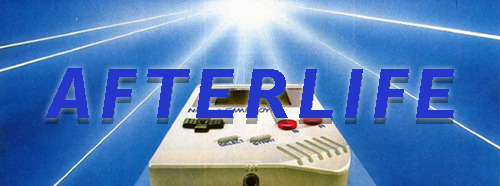
Last month, the PlayStation Vita ended production. Sony have not announced plans for a replacement system, and probably never will. The handheld market is collapsing in the face of the Mobile onslaught. The only company left in this increasingly doomed market…is Nintendo. Their 3DS system is still kicking, and the Switch is making handheld gaming cool again. The company that effectively kick-started a new front in the perpetual race that is the video game industry is now the only boxer left in the ring. And that, in no small part, is thanks to the phenomenal staying power of its penultimate punch. The Game Boy has been everywhere, from warzones to outer space. It was the first console to have a sizeable proportion of female players:
‘Nintendo of America […] says girls now make up 46 percent of players on Game Boy […] 29 percent of Nintendo Entertainment System users and 14 percent of Super Nintendo Entertainment Systems…’
The Gainesville Sun, January 15th 1995
30 years after its debut, the Game Boy’s influence remains. The prevalence of mobile gaming, ironically, owes somewhat of a debt to it. It pioneered the underlying philosophy of austerity for anywhere outside the home, which carried Nintendo’s subsequent handhelds to victory over victory. Adults made up a portion of users as well, thanks in no small part to the universal appeal of Tetris. Both of these factors are essential to mobile games, and it’s taken them to the bank.
The Game Boy could easily have capitalised on its novelty and worn out its welcome in a few years. But if there’s any console that can be called the ‘Goldilocks console’, it’s the Game Boy. Everything was just right.
unlinked sources / further reading
Blake Harris, Console Wars, 2014.
Cartridge pile image sourced from Chris Ainsworth: http://www.gaming4water.com/blog/2016/12/12/handhelds
Dave Kozicki, Ultimate Nintendo Magazine, Issue 011, May 2009.
GamePro magazine, Issue 002, July-August 1989.
GamePro Magazine, Issue 122, September 1999.
The Gainesville Sun, January 15th 1995, Makers of games focus on girls, pp. 10C-11C.
IGN, Video interview: Alexey Pajitnov Pt. 1 & 2, 12 June 2009: https://www.ign.com/videos/2009/06/12/alexey-pajitnov-stars-video-interview-alexey-pajitnov-pt-1
Nintendo Power magazine, Issue 008, September-October 1989.
Nintendo Power, Issue 011, March-April 1990.
Schmupulations.com, Gunpei Yokoi x Yukihito Morikawa: Console Gaming Then and Now – 1997 Developer Interview, 2015: http://shmuplations.com/yokoi/
Tristian Donovan, Replay: The History of Video Games, 2010.
Winnie Forster (translated & localised by Rafael Dyll and David McCarthy respectively), The encyclopedia of Game Machines: Consoles, handhelds & home computers 1972-2005, 2005.
Arana blames her stunted social skills and her general uselessness on a lifetime of video games. Between her ears is a comprehensive Team Fortress 2 encyclopedia. Her brain remains at large.












